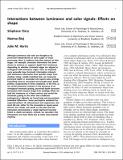Files in this item
Interactions between luminance and colour signals : effects on shape
Item metadata
| dc.contributor.author | Clery, Stephane | |
| dc.contributor.author | Bloj, Marina | |
| dc.contributor.author | Harris, Julie | |
| dc.date.accessioned | 2013-07-23T12:01:01Z | |
| dc.date.available | 2013-07-23T12:01:01Z | |
| dc.date.issued | 2013-04-18 | |
| dc.identifier | 48195193 | |
| dc.identifier | 0dbcd78f-c58c-40bb-a616-020e28479466 | |
| dc.identifier | 84878356283 | |
| dc.identifier.citation | Clery , S , Bloj , M & Harris , J 2013 , ' Interactions between luminance and colour signals : effects on shape ' , Journal of Vision , vol. 13 , no. 5 , 16 . https://doi.org/10.1167/13.5.16 | en |
| dc.identifier.issn | 1534-7362 | |
| dc.identifier.other | ORCID: /0000-0002-3497-4503/work/46085844 | |
| dc.identifier.uri | https://hdl.handle.net/10023/3861 | |
| dc.description | This research was supported by the Engineering and Physical Sciences Research Council (EPSRC). | en |
| dc.description.abstract | Although luminance and color are thought to be processed independently at early stages of visual processing, there is evidence that they interact at later stages. For example, chromatic information has been shown to enhance or suppress depth from luminance depending on whether chromatic edges are aligned or orthogonal with luminance edges. Here we explored more generally how chromatic information interacts with luminance information that specifies shape from shading. Using a depth-matching task, we measured perceived depth in sinusoidal and square-wave gratings (specifying close-to sinusoidal and triangle-wave depth profiles, respectively) in three conditions. In the first, as we varied luminance contrast in the presence of an orthogonal chromatic grating, perceived depth increased (consistent with classical shape from shading). When we held the luminance at a fixed contrast and varied the chromatic grating in the other two conditions (orthogonal or aligned), we found large and inconsistent individual differences. Some participants exhibited the expected pattern of enhancement and suppression, but most did not, either for the sinusoidal or square-wave stimuli. Our results cast doubt on the idea that the interaction demonstrates a single high-level heuristic linked to depth perception. Instead, we speculate that interactions are more likely due to early cross-channel masking | |
| dc.format.extent | 964127 | |
| dc.language.iso | eng | |
| dc.relation.ispartof | Journal of Vision | en |
| dc.rights | Copyright © 2013 by the Association for Research in Vision and Ophthalmology. This article was made open access through BIS OA funding. | en |
| dc.subject | Colour-luminance interaction | en |
| dc.subject | Colour contrast | en |
| dc.subject | Luminance contrast | en |
| dc.subject | Q Science | en |
| dc.subject.lcc | Q | en |
| dc.title | Interactions between luminance and colour signals : effects on shape | en |
| dc.type | Journal article | en |
| dc.contributor.sponsor | EPSRC | en |
| dc.contributor.institution | University of St Andrews.School of Psychology and Neuroscience | en |
| dc.contributor.institution | University of St Andrews.Institute of Behavioural and Neural Sciences | en |
| dc.identifier.doi | 10.1167/13.5.16 | |
| dc.description.status | Peer reviewed | en |
| dc.identifier.url | http://www.journalofvision.org/content/13/5/16.full | en |
| dc.identifier.grantnumber | EP/G038708/1 | en |
This item appears in the following Collection(s)
Items in the St Andrews Research Repository are protected by copyright, with all rights reserved, unless otherwise indicated.

